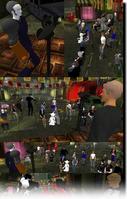| Thursday, August 18, 2005 |  |
|
|
|

by William-Adolphe Bouguereau, 1873. Bigger here
[ Culture | 2005-08-18 11:40 | | PermaLink ] More >
|
|
| Saturday, August 13, 2005 |  |
|
|
|
 I don't know, it has a certain attraction. Here's a gallery of how somebody has arranged themselves in a cave. I don't know, it has a certain attraction. Here's a gallery of how somebody has arranged themselves in a cave.
[ Culture | 2005-08-13 22:34 | | PermaLink ] More >
|
|
| Thursday, August 11, 2005 |  |
|
|
|
 A couple of art projects aimed at showing urban settings with all text removed from signs and billboards. Apparently several people got that idea. It has been done both by a little doctoring of images, and by actually covering the real signs with yellow plastic. Either way, it is interesting to notice how much text we're being bombarded with, and consider how it would be if it weren't there. A couple of art projects aimed at showing urban settings with all text removed from signs and billboards. Apparently several people got that idea. It has been done both by a little doctoring of images, and by actually covering the real signs with yellow plastic. Either way, it is interesting to notice how much text we're being bombarded with, and consider how it would be if it weren't there.
[ Culture | 2005-08-11 14:27 | | PermaLink ] More >
|
|
|
|
 I mentioned Freecycle recently. A site and a network for gift giving. Which is great. But now they sent me an e-mail about having trademarked the name, and their need to protect it, and how they couldn't allow anybody to call themselves "freecyclers" because it would dillude their mark. And the site is now blemished with "Freecycle TM". Looks stupid. Changes the whole thing. Makes it look like somebody's money-making idea, rather than a grassroots network for giving. Seems a little self-contradictory that somebody's trying very hard to own the name, when they pretend that it is all about giving. I mentioned Freecycle recently. A site and a network for gift giving. Which is great. But now they sent me an e-mail about having trademarked the name, and their need to protect it, and how they couldn't allow anybody to call themselves "freecyclers" because it would dillude their mark. And the site is now blemished with "Freecycle TM". Looks stupid. Changes the whole thing. Makes it look like somebody's money-making idea, rather than a grassroots network for giving. Seems a little self-contradictory that somebody's trying very hard to own the name, when they pretend that it is all about giving.
[ Culture | 2005-08-11 13:48 | | PermaLink ] More >
|
|
| Thursday, July 14, 2005 |  |
|
|
|
Now I'd kind of like to be able to speak Italian, since I think I'll be coming back. And it seems like it actually would be easier than French. You pronounce it like it is written, the conjugations are more simple, and many of the words are familiar. But learning a whole language is kind of a big thing.
Anyway, besides getting some beginning Italian books and a dictionary, I got a book teaching several Romance languages at the same time. Which kind of makes sense. They all come from Latin, they have many similarities, and it all becomes more clear when one is looking at the systematic differences and similarities between them.
I found an excellent book, "Comprendre les Langues Romanes", which teaches Italian, Spanish, Portuguese and Romanian to French speakers. And there's a parallel book in each of those 4 languages doing it the other way.
The book, interestingly, turns out to have been organized by some Danish professors in Romance languages, with the collaboration of colleagues in a number of countries. See, there's an idea that maybe is more likely to occur to somebody from a Scandinavian country. The 3 Scandinavian languages, Danish, Swedish and Norwegian, are to a large degree inter-comprehensible to people from those countries. Oh, they're different in many ways, almost as different as the Romance languages are. Certainly not just a matter of a different accent. At least a third of the words are different, and pronunciation has very different rules between them, different phonemes (units of sounds), etc. But the Scandinavians learn the basics about the other languages in school, and they consider each other close. So, in principle, one should be able to speak in one's own language, say Danish, and another person speaks Swedish, and we can understand each other. There will be gaps and little things one doesn't quite get, but generally that works. Even if I can't list the rules for Swedish grammar and pronunciation, I mostly understand it when a Swede speaks it, and he'd understand most of what I say in Danish.
So, the idea is that one could have the same inter-comprehensibility between the Romance languages. There's no big reason a French person shouldn't understand a Spanish or Italian speaker, and they should understand him when he speaks French. Mostly that isn't so at all, but it could be if each of them learned the basic differences and similarities, and a bit about how they've evolved.
For examples, in French the word for the English "full" is "plein". In Italian that is "pieno", in Spanish it is "lleno", "cheio" in Portuguese, and "plin" in Romanian. That at first looks very different. But they all come from the Latin "pleno". It is simply that they've converted it according to different rules. Many words that would start with pl- in French would the same way start with pi- in Italian, ll- in Spanish, ch- in Portuguese and pl- in Romanian. Which suddenly makes it easier to recognize what the words are. There are a lot of situations like that, where the differences are quite systematic, and one can see the similarities through it.
Potentially, many people could be capable of having a basic understanding of quite a few languages, if they went straight to learning how they relate to each other, how they've evolved from common roots, and what the essentially differences are between them. Which would be a very good thing for cross-cultural understanding. Less of a Tower of Babel. Maybe you don't master the languages, but you can understand most of them.
But, hey, maybe there's a conspiracy against it. There is a curious coincidence in this book. Its main author is listed as Paul Teyssier, a Danish language professor. But the foreword is by a different Danish language professor, Jørgen Schmitt Jensen, the project's coordinator,who gives a lively introduction to the book, and ends with the sad note that Mr.Teyssier unfortunately has passed away, so therefore, in his place, he would be writing the introduction to Romance languages. And then, under that, there's another note, from somebody else, that unfortunately, because of Mr.Schmitt Jensen's untimely illness and death, the introduction will not be written by him either, but by so-and-so. Who apparently survived through it. But it is a bit like they all get killed off, because they have the audacity to teach more people to understand each other. Nah, they were probably just old, but one never knows.
[ Culture | 2005-07-14 16:48 | | PermaLink ] More >
|
|
| Thursday, June 9, 2005 |  |
|
|
|
Collision Detection talks about a different way of publishing. A couple of board game designers wanted to publish a game online in PDF format, but were worrying about not getting paid, because people easily could pirate their work. So they thought about a new way of doing it.Last December, Stolze and Holis invented what they call "the ransom model". It works like this: They described the basic gist of the game on their web site, and set a ransom of $600 for it. If they received $600 in donations by September 2005, they would finish creating the game -- and then release it on their site, for anyone to download for free. (If they didn't get the full $600 in time, they would donate whatever money they'd received to a homeless shelter.) As they explained, the ransom model is a win-win for lots of reasons:
"First off, it makes piracy a non-issue: As soon as the property is available to anyone, it's free for everyone. Secondly, it keeps the prices reasonable for the buyer, by definition. From where I sit, there is no conceivable way anyone can feel ripped off with this setup, since no one is being asked to front more than they're comfortable spending."
And it worked. In only four months, Stoltze and Solid got the full $600 they asked for, and now anyone can freely download the game from their site.
I had actually thought about such ideas as a possibility for how one would finance large scale projects in grassroots economies. Like, if we all were trafficking in alternative currencies that weren't issued by banks or governments, and if there weren't huge corporations on the stock exchange, and we maybe even arranged for most things to be free, how would we get bridges built, and how would expensive movies get made?
It isn't unfathomable that the same approach could be used, with some refinements. Essentially you would put out your proposal, what you would like to do, and what you think it would cost. And people would examine it, and they would examine your reputation for doing good things. And then they would vote with their currency, in advance, before the product gets made. If enough people think it is worthwhile, it gets made. If not, it doesn't. I bet Star Wars would easily have been financed that way. And the war in Iraq wouldn't. And we'd have space elevators and expeditions to Mars much faster.
[ Culture | 2005-06-09 02:12 | | PermaLink ] More >
|
|
| Monday, June 6, 2005 |  |
|
|
|
 Article in New York Times about an economist who does economic experiments with monkeys. And he finds that they behave like people in many ways. Article in New York Times about an economist who does economic experiments with monkeys. And he finds that they behave like people in many ways.Two monkeys faced each other in adjoining cages, each equipped with a lever that would release a marshmallow into the other monkey's cage. The only way for one monkey to get a marshmallow was for the other monkey to pull its lever. So pulling the lever was to some degree an act of altruism, or at least of strategic cooperation.
The tamarins were fairly cooperative but still showed a healthy amount of self-interest: over repeated encounters with fellow monkeys, the typical tamarin pulled the lever about 40 percent of the time. Then Hauser and Chen heightened the drama. They conditioned one tamarin to always pull the lever (thus creating an altruistic stooge) and another to never pull the lever (thus creating a selfish jerk). The stooge and the jerk were then sent to play the game with the other tamarins. The stooge blithely pulled her lever over and over, never failing to dump a marshmallow into the other monkey's cage. Initially, the other monkeys responded in kind, pulling their own levers 50 percent of the time. But once they figured out that their partner was a pushover (like a parent who buys her kid a toy on every outing whether the kid is a saint or a devil), their rate of reciprocation dropped to 30 percent -- lower than the original average rate. The selfish jerk, meanwhile, was punished even worse. Once her reputation was established, whenever she was led into the experimenting chamber, the other tamarins "would just go nuts," Chen recalls. "They'd throw their feces at the wall, walk into the corner and sit on their hands, kind of sulk."
He also learned that the monkeys might cheat or steal to get what they want. And they might think of new kinds of exchanges, like paying for sex, or trying to pass on counterfeit coins. And they would make the same kind of irrational choices as humans tend to, like making certain choices, when presented with a gamble, which seem emotionally satisfying, but which might not be rational.When taught to use money, a group of capuchin monkeys responded quite rationally to simple incentives; responded irrationally to risky gambles; failed to save; stole when they could; used money for food and, on occasion, sex. In other words, they behaved a good bit like the creature that most of Chen's more traditional colleagues study: Homo sapiens.
Now, this is all a somewhat touchy subject with economists, because economic theory traditionally assumes that it is only humans who can act economically, based on our ability to think rationally. Which is probably a bunch of crap, as humans don't think very rationally half the time, and most economic choices aren't rational. Might very well have a lot more to do with being conditioned. You want this tasty banana (car, tv, house), push this button (go downtown and push papers around all day).
[ Culture | 2005-06-06 21:54 | | PermaLink ] More >
|
|
| Thursday, June 2, 2005 |  |
|
|
|
 Oh, I'd love to see a Royal de Luxe show. They're these crazy French street performers who tend to construct very weird and elaborate machines and scenery for their spectacles. There was this exhibition last year in Toulouse, at the modern art museum, of a whole bunch of their old machines. You know, piano throwing machines, flame spewing monsters, etc. But I haven't seen a real show. Recently they did a parade in Nantes, which involved a giant little girl, who arrived in a rocket, and there was a mechanical elefant, and various other wonders. Apparently it had something to do with celebrating Jules Verne. Here's a great commented gallery. Oh, I'd love to see a Royal de Luxe show. They're these crazy French street performers who tend to construct very weird and elaborate machines and scenery for their spectacles. There was this exhibition last year in Toulouse, at the modern art museum, of a whole bunch of their old machines. You know, piano throwing machines, flame spewing monsters, etc. But I haven't seen a real show. Recently they did a parade in Nantes, which involved a giant little girl, who arrived in a rocket, and there was a mechanical elefant, and various other wonders. Apparently it had something to do with celebrating Jules Verne. Here's a great commented gallery.
[ Culture | 2005-06-02 22:49 | | PermaLink ] More >

|
|
| Saturday, May 7, 2005 |  |
|
|
|
 Last week was the first meeting of the Second Life Future Salon. I used to go to the monthly futurist salons in L.A. spearheaded by John Smart, which was always enjoyable. A group of very bright techie, transhumanist futurists, and always great speakers. Since then affiliated salons have popped up in other places, San Francisco, San Diego and Las Vegas. And now this is the first one in virtual space, in the Second Life virtual world. Which means I can be there, even if it is at 4AM where I am in France. Last week was the first meeting of the Second Life Future Salon. I used to go to the monthly futurist salons in L.A. spearheaded by John Smart, which was always enjoyable. A group of very bright techie, transhumanist futurists, and always great speakers. Since then affiliated salons have popped up in other places, San Francisco, San Diego and Las Vegas. And now this is the first one in virtual space, in the Second Life virtual world. Which means I can be there, even if it is at 4AM where I am in France.
I was a bit late, and it took me a while to find it. I haven't used Second Life more than a couple of times. It was in a China Town simulation, which was pretty cool, but how to find it? I basically scanned over the world map, which is huge, until I found a suitably large group of people that I could teleport to. People, well, what is there is avatars, virtual bodies. And, well, it is weird compared with a "meat space" meeting. People can have all sorts of wild costumes, and wings and robotic arms or whatever suits them. And you can fly or walk or ride a motorcycle or teleport, or whatever. But you still go to a meeting hall with chairs and sit down, and there is a speaker up front, and you sit and fiddle or look around at who else is there. They had hooked up some new audio conferencing capability so you could hear the speaker. Otherwise you type to each other in speech bubbles or chat windows.
Well, what's interesting is how serious this is. It isn't just some kids trying to pass their spare time with a game. Rather, we have academics and professionals who dedicate quite some effort to making virtual worlds more viable for various kinds of activities, and who study the dynamics of what happen there. How you best do business there, whether you can telecommute from there, what kinds of infrastructure is needed, etc.
Lots of interesting stuff on the Second Life Future Salon Blog, like the article The Flat Earth's Shaky Virtual Ground on the interesting phenomenon of low-wage Chinese workers being employed to play online games in virtual worlds and gather stuff of value that can be sold, and how they get into a puzzling situation in a place like Second Life, where it isn't really a game, but where you can very well make good money in real estate speculation or by starting businesses, but it requires understanding how a capitalist economy works. And if you do, you wouldn't really have to work for peanuts for somebody else in a sweatshop for virtual workers.
[ Culture | 2005-05-07 15:39 | | PermaLink ] More >
|
|
| Tuesday, April 19, 2005 |  |
|
|
|
 In 1985 Bob Black wrote a brilliant essay called "The Abolition of Work". A monumentally brilliant manifesto, in my opinion. Suggesting, as it says, that we abolish work all together, and instead live playful lives. He outlines in colorful ways the tyranny of work, and the insanities we're putting up with in the name of work. And he outlines the faulty foundation the whole scheme is based on. I will include the whole essay in the "More" link as it isn't copyrighted. So just one quote here: In 1985 Bob Black wrote a brilliant essay called "The Abolition of Work". A monumentally brilliant manifesto, in my opinion. Suggesting, as it says, that we abolish work all together, and instead live playful lives. He outlines in colorful ways the tyranny of work, and the insanities we're putting up with in the name of work. And he outlines the faulty foundation the whole scheme is based on. I will include the whole essay in the "More" link as it isn't copyrighted. So just one quote here:Work makes a mockery of freedom. The official line is that we all have rights and live in a democracy. Other unfortunates who aren't free like we are have to live in police states. These victims obey orders or-else, no matter how arbitrary. The authorities keep them under regular surveillance. State bureaucrats control even the smaller details of everyday life. The officials who push them around are answerable only to higher-ups, public or private. Either way, dissent and disobedience are punished. Informers report regularly to the authorities. All this is supposed to be a very bad thing.
And so it is, although it is nothing but a description of the modern workplace. The liberals and conservatives and libertarians who lament totalitarianism are phonies and hypocrites. There is more freedom in any moderately deStalinized dictatorship than there is in the ordinary American workplace. You find the same sort of hierarchy and discipline in an office or factory as you do in a prison or monastery. In fact, as Foucault and others have shown, prisons and factories came in at about the same time, and their operators consciously borrowed from each other's control techniques. A worker is a part time slave. The boss says when to show up, when to leave, and what to do in the meantime. He tells you how much work to do and how fast. He is free to carry his control to humiliating extremes, regulating, if he feels like it, the clothes you wear or how often you go to the bathroom. With a few exceptions he can fire you for any reason, or no reason. He has you spied on by snitches and supervisors, he amasses a dossier on every employee. Talking back is called "insubordination," just as if a worker is a naughty child, and it not only gets you fired, it disqualifies you for unemployment compensation. Without necessarily endorsing it for them either, it is noteworthy that children at home and in school receive much the same treatment, justified in their case by their supposed immaturity. What does this say about their parents and teachers who work?
The demeaning system of domination I've described rules over half the waking hours of a majority of women and the vast majority of men for decades, for most of their lifespans. For certain purposes it's not too misleading to call our system democracy or capitalism or -- better still -- industrialism, but its real names are factory fascism and office oligarchy. Anybody who says these people are "free" is lying or stupid. You are what you do. If you do boring, stupid monotonous work, chances are you'll end up boring, stupid and monotonous. Work is a much better explanation for the creeping cretinization all around us than even such significant moronizing mechanisms as television and education. People who are regimented all their lives, handed off to work from school and bracketed by the family in the beginning and the nursing home at the end, are habituated to heirarchy and psychologically enslaved. Their aptitude for autonomy is so atrophied that their fear of freedom is among their few rationally grounded phobias. Their obedience training at work carries over into the families they start, thus reproducing the system in more ways than one, and into politics, culture and everything else. Once you drain the vitality from people at work, they'll likely submit to hierarchy and expertise in everything. They're used to it. He's right. However, what he is saying is ironically also so radical that few people will be able to understand it. Most people will come up with a lot of "but... but... but..."s, trying to justify why they're wasting their lives. Well, it mostly adds up to "because we have to", which is exactly what makes work be work. Because the cards are stacked in such a way that we apparently have to work in order to eat, unless we're very lucky, or very smart, so we can manage to arrange things so we don't.
As he points out, most work is useless, non-sensical, wasted. But the people who do it have a lot invested in claiming otherwise. All the stuff we need could be produced by probably less than 5% of the effort we expend at work. And that is not even getting to the cool, new, interesting, different things we could do if we actually had fun and acted playfully instead of as slaves. And how much more productive we could be, ironically.
It probably isn't going to change before somebody demonstrates that clearly enough and often enough. And it might ironically be quite likely that it will be businesses who figure out how to produce much more by being playful rather than work oriented, and who therefore will gain an advantage.
[ Culture | 2005-04-19 16:06 | | PermaLink ] More >
|
|
| Thursday, April 7, 2005 |  |
|
|
|
 "The World" is a group of 300 artificial islands constructed off the coast of Dubai, shaped to look like a map of the world when seen from above. The development covers an area 9km by 6km and there's 50-100 meters between islands. Connected with water taxis, patrolled by a Beverly Hills type police force. The islands are for sale for private estate homes, resorts, golf courses, or whatever you might have in mind. Your imagination is the limit. Well, that's what so bizarre. It seems so very virtual. Just like buying an island in some online virtual world. You want a fairy tale castle, a rain forest - go ahead. The main difference is that the cheapest island here is around $7 million, and that's without the cost of whatever it is you might imagine. "The World" is a group of 300 artificial islands constructed off the coast of Dubai, shaped to look like a map of the world when seen from above. The development covers an area 9km by 6km and there's 50-100 meters between islands. Connected with water taxis, patrolled by a Beverly Hills type police force. The islands are for sale for private estate homes, resorts, golf courses, or whatever you might have in mind. Your imagination is the limit. Well, that's what so bizarre. It seems so very virtual. Just like buying an island in some online virtual world. You want a fairy tale castle, a rain forest - go ahead. The main difference is that the cheapest island here is around $7 million, and that's without the cost of whatever it is you might imagine.
[ Culture | 2005-04-07 13:44 | | PermaLink ] More >
|
|
| Friday, April 1, 2005 |  |
|
|
|
And here's a site listing an assortment of practical jokes carried out on the net today.
[ Culture | 2005-04-01 21:20 | | PermaLink ] More >
|
|
|
|
 Google announces the introduction of Google Gulp (beta), a drink that will make you smart enough to actually understand your search results. Google announces the introduction of Google Gulp (beta), a drink that will make you smart enough to actually understand your search results.Think a DNA scanner embedded in the lip of your bottle reading all 3 gigabytes of your base pair genetic data in a fraction of a second, fine-tuning your individual hormonal cocktail in real time using our patented Auto-Drink™ technology, and slamming a truckload of electrolytic neurotransmitter smart-drug stimulants past the blood-brain barrier to achieve maximum optimization of your soon-to-be-grateful cerebral cortex. Plus, it's low in carbs! And with flavors ranging from Beta Carroty to Glutamate Grape, you'll never run out of ways to quench your thirst for knowledge. Gee, they seem to be everywhere, those Google guys.
[ Culture | 2005-04-01 14:37 | | PermaLink ] More >
|
|
|
|
 If you think that BoingBoing might be a little too interesting, you can now switch over to BoringBoring, a directory of dull things. And it doesn't disappoint. It highlights dull products such as plain white t-shirts and flat surfaces to put things on. And uninspired suggestions like taking your knitting needles on a plane, and constructing two-dimensional surfaces from yarn. If you think that BoingBoing might be a little too interesting, you can now switch over to BoringBoring, a directory of dull things. And it doesn't disappoint. It highlights dull products such as plain white t-shirts and flat surfaces to put things on. And uninspired suggestions like taking your knitting needles on a plane, and constructing two-dimensional surfaces from yarn.
[ Culture | 2005-04-01 14:27 | | PermaLink ] More >
|
|
|
|
 Web Waste is the Internet Rubbish Dump. Instead of just emptying your trash or recycle bin, you run a little application which uploads it to this site. And then people can see a nice Flash animation of all the pictures, videos, sounds and pieces of text that people have thrown away. So, nothing goes to waste. Web Waste is the Internet Rubbish Dump. Instead of just emptying your trash or recycle bin, you run a little application which uploads it to this site. And then people can see a nice Flash animation of all the pictures, videos, sounds and pieces of text that people have thrown away. So, nothing goes to waste.
[ Culture | 2005-04-01 14:20 | | PermaLink ] More >
|
|
| Monday, March 28, 2005 |  |
|
|
|
 An assortment of troublemakers have fun throwing wrenches into the wheels of commerce. To make a point, I guess, about commercialism and consumerism and big corporations. Like there's gatt.org, a parody of a World Trade Organization website, so well done that they've accidentally been invited to speak at WTO conferences, which they exploited to the hilt with outrageous performances. Here are some other exploits: An assortment of troublemakers have fun throwing wrenches into the wheels of commerce. To make a point, I guess, about commercialism and consumerism and big corporations. Like there's gatt.org, a parody of a World Trade Organization website, so well done that they've accidentally been invited to speak at WTO conferences, which they exploited to the hilt with outrageous performances. Here are some other exploits: A group calling itself Whirl-Mart infests the halls of commerce with site-appropriate dance: The ritual consists of interested humans arriving at a predetermined Wal-Mart at 12 noon on the first Sunday of every month and proceeding to push empty shopping carts slowly and silently through the aisles. Eventually, all of the participants locate one another and form a single-file chain of anti-shoppers which weaves, wanders, and whirls throughout the different departments of the store for about an hour. Overall, it is a soothing and fun experience for the actors, and perhaps a memorable spectacle for shoppers. It is a collective reclamation of space that is otherwise only used for buying and selling. It is a symbolic display of the will to resist the capitalist ideology. And, it is a living, breathing, moving, evolving sculpture.
A parody group calling itself the Organization of Corporations Against Coöperation staged a protest against small business and in favor of giant corporations. They picketed a small bookshop with signs saying things like "Size Does Matter" and urged passers-by to patronize instead huge chain bookstores. The same group later managed to get a branch of one such giant bookstore chain to close for one day - they masqueraded as a pro-corporate taskforce who was monitoring local anti-corporate activity and said that a planned protest might get out-of-hand, recommending that the bookstore close up shop for the day of the protest. Or, how about the guys who create prayer services where they gather in supermarkets to worship the wonderful products that we're presented with. "Praise the fresh chickens and their fleshy whiteness!". Yeah, halleluja.
[ Culture | 2005-03-28 14:11 | | PermaLink ] More >
|
|
|
|
 Trepanation was quite popular in the middle ages, and even in pre-historic ages, as a supposed cure for an assortment of ailments. It is essentially that one drills a hole in somebody's head, or cuts out a triangular piece of their skull. Which there could be some legitimate use of, if your brain is swollen, for example. But nowadays there are people who advocate it as being good for somehow increasing your consciousness. So, read the story of this guy who thought it might be a good idea, and did the operation with the help of a couple of friends, a trip to a medical supply store, and some instructional videos. He survived alright, and was happy with it at first, but ended up concluding it probably wasn't such a good idea. Yeah, well, it probably wasn't. Trepanation was quite popular in the middle ages, and even in pre-historic ages, as a supposed cure for an assortment of ailments. It is essentially that one drills a hole in somebody's head, or cuts out a triangular piece of their skull. Which there could be some legitimate use of, if your brain is swollen, for example. But nowadays there are people who advocate it as being good for somehow increasing your consciousness. So, read the story of this guy who thought it might be a good idea, and did the operation with the help of a couple of friends, a trip to a medical supply store, and some instructional videos. He survived alright, and was happy with it at first, but ended up concluding it probably wasn't such a good idea. Yeah, well, it probably wasn't.
[ Culture | 2005-03-28 02:00 | | PermaLink ] More >
|
|
| Friday, March 25, 2005 |  |
|
|
|
 Banksy is a renegade artist who sneaks his culture jamming socially critical pictures into places they don't belong, like big museums. To see how long they get to stay before anybody notices. He's getting a lot of publicity recently, after managing to hang his pictures in four prestigious New York Museums. Other pictures he leaves as graffiti on walls, or, eh, on cows. I don't know about the cow graffiti, but the cows probably didn't mind overly much. Banksy is a renegade artist who sneaks his culture jamming socially critical pictures into places they don't belong, like big museums. To see how long they get to stay before anybody notices. He's getting a lot of publicity recently, after managing to hang his pictures in four prestigious New York Museums. Other pictures he leaves as graffiti on walls, or, eh, on cows. I don't know about the cow graffiti, but the cows probably didn't mind overly much.
[ Culture | 2005-03-25 18:03 | | PermaLink ] More >
|
|
|
|
 Wade Roush made some thorough Notes from a very nice speech by Lawrence Lessig last week. About how important it is that we're free to remix media, as we always could before the digital age. You know, you could buy a magazine, cut out the pictures and make a collage and show it to people. And you can make a funny hat out of the rest of the magaine. Now, with the internet and lots of new tools, people are doing all sorts of creative things that reuse content in interesting ways. But there are strong forces that are trying to make all of that illegal. If they have their way, you can only use media they've sold you in the exact way they had in mind. You know, you can only watch this DVD twice, and only on your own TV. Or you can only watch this broadcast program on Thursdays and you can't fastforward over the commercials. No getting creative and using it differently. Wade Roush made some thorough Notes from a very nice speech by Lawrence Lessig last week. About how important it is that we're free to remix media, as we always could before the digital age. You know, you could buy a magazine, cut out the pictures and make a collage and show it to people. And you can make a funny hat out of the rest of the magaine. Now, with the internet and lots of new tools, people are doing all sorts of creative things that reuse content in interesting ways. But there are strong forces that are trying to make all of that illegal. If they have their way, you can only use media they've sold you in the exact way they had in mind. You know, you can only watch this DVD twice, and only on your own TV. Or you can only watch this broadcast program on Thursdays and you can't fastforward over the commercials. No getting creative and using it differently."We’ve set up a system of regulation so that these forms of expression are illegal. So we can’t teach them to our kids--that would be schools promoting piracy. We can’t promote them with our businesses. All we can do is focus on how to punish those who write with the ordinary tools of the 21st century.
Existing law conflicts with the technology of the 21st century and that gives us a choice: Reform the law or reform the technology. Since 1998 there has been a clear choice—it was made for us by our own village doctors. They assembled in Congress and what they have collectively given us as an answer to this choice--reforming the law or reforming the technology--is to utter the words of HG Wells: To cure them, all we need to do is a simple and easy surgical operation, namely to remove the irritant body, the machines, your technology. They want to blind us. To conform us to 18th century law." He's making a very appropriate reference to an HG Wells story about somebody arriving in a city of blind people, and not quite behaving "right" according to their norms before they got the bright idea of removing what was wrong with him - his eyes.
[ Culture | 2005-03-25 15:35 | | PermaLink ] More >
|
|
| Monday, March 21, 2005 |  |
|
|
|
 These are some quotes from Sam Harris who's written a book called "The end of Faith. Religion, Terror and the Future of Reason. I haven't read it. Looked at first glance like it was just an attempt to debunk religion and replace it with materialism. But it seems smarter than that. He says a bunch of things I like. These are some quotes from Sam Harris who's written a book called "The end of Faith. Religion, Terror and the Future of Reason. I haven't read it. Looked at first glance like it was just an attempt to debunk religion and replace it with materialism. But it seems smarter than that. He says a bunch of things I like.A belief is a lever that, once pulled, moves almost everything else in a person’s life. Are you a scientist? A liberal? A racist? These are merely species of belief in action. Your beliefs define your vision of the world; they dictate your behavior; they determine your emotional responses to other human beings. If you doubt this, consider how your experience would suddenly change if you came to believe one of the following propositions: 1. You have only two weeks to live. 2. You’ve just won a lottery prize of one hundred million dollars. 3. Aliens have implanted a receiver in your skull and are manipulating your thoughts.[...]
Tell a devout Christian that his wife is cheating on him, or that frozen yogurt can make a man invisible, and he is likely to require as much evidence as anyone else, and to be persuaded only to the extent that you give it. Tell him that the book he keeps by his bed was written by an invisible deity who will punish him with fire for eternity if he fails to accept its every incredible claim about the universe, and he seems to require no evidence whatsoever.[...]
While Eastern mysticism has its fair share of unjustified belief, it undoubtedly represents humankind's best attempt at fashioning a spiritual science. The methods of introspection one finds in Buddhism, for instance, have no genuine equivalents in the West. And the suggestion that they do is born of a desperate attempt on the part of Westerners to make all religious traditions seem equally wise. They simply aren't. When a Tibetan lama talks about "nondual awareness" (Tib. rigpa) and the Pope talks about God or the Holy Spirit (or anything else), they are not talking about the same thing; nor are they operating on the same intellectual footing. The lama is using some very precise terminology (albeit terminology that has no good English equivalent) to describe what countless meditators have experienced after very refined training in methods of introspection; while the Pope is merely reiterating unjustified and unjustifiable metaphysical claims that have been passed down to Christians in the context of a culture that has failed--utterly--to find compelling alternatives to mere belief. Such alternatives have existed for millennia, east of the Bosporus. This is not to ignore the Meister Eckharts of the world, but such mystics have always been the exception in the West. And it is important to remember that, being exceptions, they have been regularly persecuted for heresy.
Mysticism, shorn of religious dogmatism, is an empirical and highly rational enterprise. Just as people do not burn their neighbors at the stake as a result of new insights in physics or biology, no one is likely to do so on the basis of genuine mysticism. Religion--especially in the West--is another matter entirely. Religious faith is a conversation stopper.
The only thing that guarantees a truly open-ended collaboration among human beings is their willingness to have their views (and resulting behavior) modified by conversation--by new evidence and new arguments. Otherwise, when the stakes are high, there is nothing to appeal to but force. If I believe that I can get to Paradise by flying a plane into a building, and I am content to believe this without evidence, then there will be nothing another person can say to dissuade me, because my leap of faith has made me immune to the powers of conversation.[...]
"Faith" is false conviction in unjustified propositions (a certain book was written by God; we will be reunited with our loved ones after death; the Creator of the universe can hear our thoughts, etc.). "Spirituality" or "mysticism" (both words are pretty terrible, but there are no good alternatives in English) refers to any process of introspection by which a person can come to realize that the feeling he calls "I" is a cognitive illusion. The core truth of mysticism is this: It is possible to experience the world without feeling like a separate "self" in the usual sense. Such a change in the character of one's experience need not become the basis for making unsupportable claims about the nature of the universe, however. Excellent point about the willingness to let one's views be modified by conversation, by new evidence, by introspection. If we can make a shared culture based on that, I'd say we're doing alright, even if we don't agree on everything. Mysticism and Reason aren't mutually exclusive. Neither is Science and Spirituality. But blind faith, involving no corrective feedback loop, that's the problem.
[ Culture | 2005-03-21 16:52 | | PermaLink ] More >
|
|
<< Newer stories Page: 1 2 3 4 5 6 7 8 9 10 Older stories >> |

